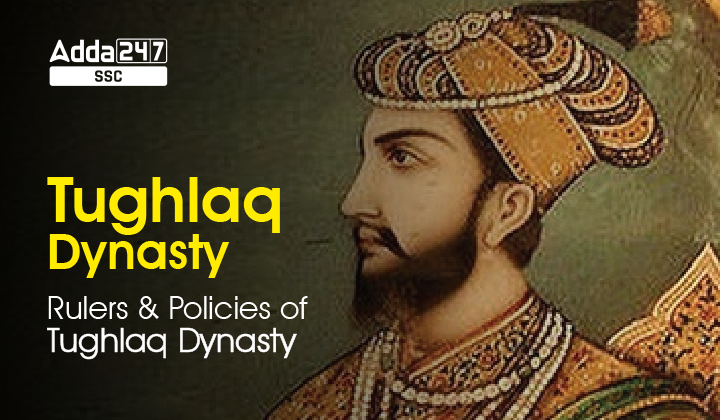The Tughlaq dynasty, also known as the Quaraunah Turks, ruled the Delhi Sultanate from 1320 to 1414 CE. The dynasty was founded by Ghiyasuddin Tughlaq, who was a skilled military leader and administrator.
Founder of Tughlaq Dynasty
Ghazi Malik, the governor of Dipalpur, killed Khusrau Khan (last ruler of Khilji Dynasty) and ascended the throne of Delhi under the title of Ghiyasuddin Tughlaq in 1320 CE.
About Tughlaq Dynasty
|
Place
|
Delhi
|
|
Period
|
1320 AD- 1414 AD
|
|
Language
|
Urdu
|
|
Religion
|
Sunni Islam
|
|
Founder
|
Ghiyasuddin Tughlaq
|
Tughlaq Dynasty Rulers
| Ruler |
|---|
| Ghiyasuddin Tughlaq |
| Muhammad bin Tughlaq |
| Firoz Shah Tughlaq |
| Muhammad Khan |
| Ghiyasuddin Tughlaq Shah II |
| Abu Bakr Shah |
| Nasiruddin Muhammad |
| Mahmud Tughlaq |
| Daulat Khan |
- Study Notes On Gupta Dynasty: Rulers, Overview, Important Points and FAQs
- Important Notes on Mughal Empire : Rulers, Fall of Empire, Overview and FAQs
Ghiyasuddin Tughlaq 1320-25 AD
Ghiyas-ud-din Tughluq or Ghazi Malik was the founder of the Tughluq dynasty. Tughluq’s policy was harsh against the Mongols.
- He was the first Sultan to take the title of Ghazi (Slayer of Infidels) and initiate irrigation works.
- Ghiyasuddin built the strong fort of Tughlaqabad near Delhi and dispatched his son, Jauna Khan, to re-establish authority in Warangal and Madurai.
- He had a troubled relationship with the Sufi saint Sheikh Nizamuddin Aulia.
- Ghiyasuddin’s reign ended when he died due to the collapse of a wooden structure, which some scholars like Ibn Batuta believe that his son (Jauna Khan) might have planned this accident to kill him.
Muhammad bin Tughlaq (1325-1351 CE):
- Mohammad Bin Tughlaq, also known as Jauna Khan, ruled from c.1325–51 CE. He is known as “Wisest Fool” due to his ambitious schemes and failed experiments.
- Ziauddin Barni a philosopher mentions his five major experiments
a) Capital transfer from Delhi to Devagiri (Daulatabad)
b) Planned invasion of Khurasan and Iraq (abandoned)
c) Increased land revenue in Doab region
d) Introduction of token currency (copper coins)
e) Unsuccessful Qarachill expedition (Kumaon Hills) - Mohammad Bin Tughlaq was highly educated, knowing Arabic and Persian, and was skilled in various subjects including philosophy, astronomy, logic, and mathematics.
- He created the department of Agriculture (Diwan-i-Amir-kohi) and provided takkavi loans to farmers.
- During his reign, the famous traveler Ibn Batuta visited India and served as a Qazi in Delhi for eight years.
- Mohammad Bin Tughlaq also built the fort of Adilabad and the city of Jahanpanah.
Firoz Shah Tughlaq (1351-1388 CE):
- Firoz Shah Tughlaq was chosen as Sultan by the nobles.
- He appointed Khan-i-Jahan Maqbal, a Telugu Brahmin convert, as his Wazir.
- Firoz led campaigns against Bengal, Jajnagar (modern Orissa), Nagarkot, and Thatta.
- He imposed four kind of Taxes
- Kharaj – Land Tax (1/10 of the produce given as Tax)
- Zakat – 2% Tax on Property
- Jaziya – Levied on Non-Muslim
- Khams- 1/5 of booty captured during the war.
- Firoz revived the Iqtadari system, making it hereditary, and introduced the Haq-i-Sharb (irrigation tax).
- He built several canals, developed royal factories (karkhanas), and constructed about 300 new towns, including Firozabad near Red Fort in Delhi, Jaunpur & Hisar
- He rebuilt two stories of Qutub Minar which were damaged by lightning in 1368 AD.
- Introduced 2 new coins: Adha (50% Jital) and Bitch (23% Jital)
- Firoz Shah repaired old monuments, including the Qutab Minar, and transported Ashokan pillars to Delhi.
- He created the Diwan-i-Khairat for charity and established free hospitals and marriage bureaus for poor Muslims.
- Firoz also patronized scholars like Barauni (famous historian who wrote Tarikh-i-Firoz Shah and Futwa-i-Jahandari) and Khwajja Abdul Malik Islami (who wrote Futah-Us-Sulatin) and wrote Futuhat-e-firozshahi.
Decline of the Dynasty:
- After Firoz Shah’s death, the Tughlaq dynasty saw a rapid decline. Subsequent rulers included Muhammad Khan, Ghiyaddin Tughlaq Shah II, Abu Bakr Shah, and Nasiruddin Muhammad.
- The last Tughlaq ruler was Daulat Khan, who was defeated by Khizr Khan, the founder of the Saiyyad Dynasty.
- While Mohammad Bin Tughlaq was in power, three new kingdoms formed in South India: Vijayanagar, Bahmani, and Madurai.
- In 1398, Timur attacked India. He raided Delhi for three days, causing a lot of damage and stealing many things. This attack, plus the fact that areas like Malwa and Gujarat broke away to rule themselves, led to the Decline of Tughlaq Dynasty.



 Upcoming Government Exams, Complete Govt...
Upcoming Government Exams, Complete Govt...
 Govt Jobs 2025, Latest Upcoming Governme...
Govt Jobs 2025, Latest Upcoming Governme...
 SSC Exam Calendar 2025–26 Out, Check All...
SSC Exam Calendar 2025–26 Out, Check All...









